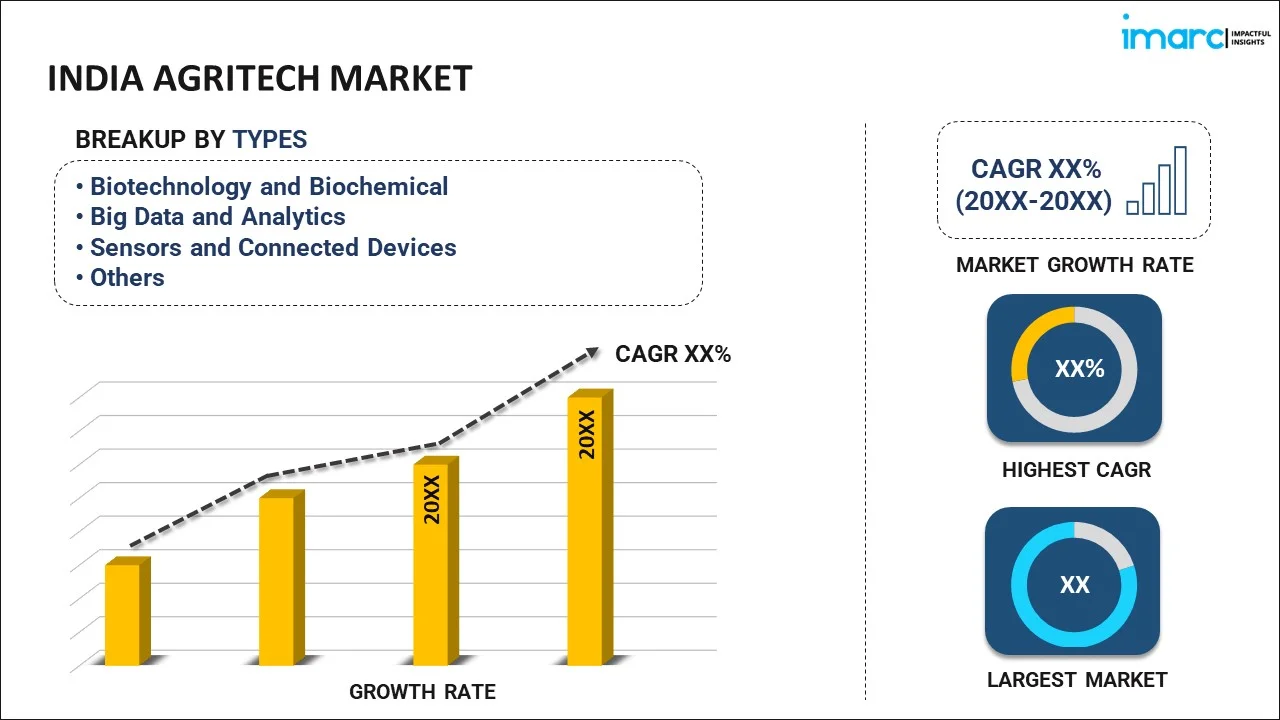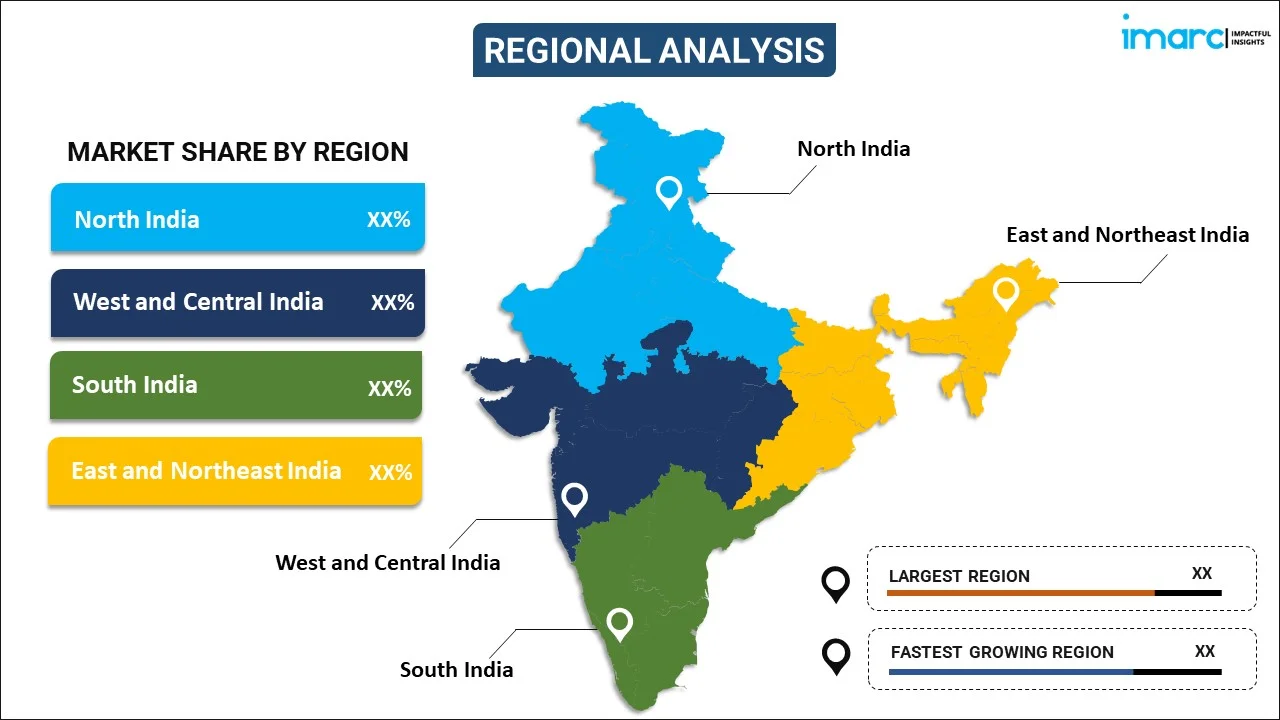
India Agritech Market Report by Type (Biotechnology and Biochemical, Big Data and Analytics, Sensors and Connected Devices, Mobility, and Others), Application (Irrigation, Production and Maintenance, Supply Chain, Marketplace), and Region 2025-2033
Market Overview:
India agritech market size reached USD 878.1 Million in 2024. Looking forward, IMARC Group expects the market to reach USD 6,152.3 Million by 2033, exhibiting a growth rate (CAGR) of 10.93% during 2025-2033. The growing demand for sustainable practices, along with the inflating popularity of risk mitigation tools among farmers, is primarily driving the market growth.
|
Report Attribute
|
Key Statistics
|
|---|---|
|
Base Year
|
2024
|
|
Forecast Years
|
2025-2033
|
|
Historical Years
|
2019-2024
|
|
Market Size in 2024
|
USD 878.1 Million |
|
Market Forecast in 2033
|
USD 6,152.3 Million |
| Market Growth Rate 2025-2033 | 10.93% |
Agritech, also known as agricultural technology, represents an innovative field that encompasses a diverse range of applications, from precision farming and data-driven decision-making to the implementation of advanced machinery and automation. It also aims to optimize agricultural processes, enhance productivity, and ensure sustainable practices in the face of evolving global demands and environmental considerations. In line with this, it seamlessly integrating technological advancements with traditional farming practices, agritech also holds the promise of revolutionizing the agriculture industry, offering solutions that improve efficiency, resource management, and overall yield. This introduction sets the stage for exploring the multifaceted realm of agritech, where technology becomes a transformative force, ushering in a new era of smart and sustainable agriculture.
India Agritech Market Trends:
The India agritech market size is propelled by a convergence of factors that are reshaping traditional agricultural practices and paving the way for innovative solutions. Firstly, the increasing penetration of digital technologies in rural areas is a significant driver. As access to smartphones and the internet expands, farmers in India are gaining access to real-time information, weather forecasts, and market prices, empowering them to make informed decisions and optimize their farming strategies. Moreover, the rising awareness of sustainability and environmental impact is influencing agritech trends in India. Besides this, farmers and stakeholders are increasingly turning to precision agriculture, leveraging technologies, such as IoT sensors and drones to optimize resource use, reduce waste, and minimize environmental impact. This shift towards sustainable practices aligns with the broader commitment to eco-friendly agriculture. Additionally, the emergence of fintech solutions in agritech is addressing financial challenges faced by farmers. Digital platforms offering credit facilities, insurance, and payment systems are gaining prominence, providing farmers with financial inclusion and risk mitigation tools. Furthermore, the inflating need for contactless and efficient farming practices has led to increased interest in automation, robotics, and remote monitoring technologies. This, in turn, is expected to fuel the market growth over the forecasted period.
India Agritech Market Segmentation:
IMARC Group provides an analysis of the key trends in each segment of the market, along with forecasts at the country level for 2025-2033. Our report has categorized the market based on type and application.
Type Insights:

- Biotechnology and Biochemical
- Big Data and Analytics
- Sensors and Connected Devices
- Mobility
- Others
The report has provided a detailed breakup and analysis of the market based on the type. This includes biotechnology and biochemical, big data and analytics, sensors and connected devices, mobility, and others.
Application Insights:
- Irrigation
- Production and Maintenance
- Supply Chain
- Marketplace
A detailed breakup and analysis of the market based on the application have also been provided in the report. This includes irrigation, production and maintenance, supply chain, and marketplace.
Regional Insights:

- North India
- West and Central India
- South India
- East and Northeast India
The report has also provided a comprehensive analysis of all the major regional markets, which include North India, West and Central India, South India, and East and Northeast India.
Competitive Landscape:
key player positioning, top winning strategies, competitive dashboard, and company evaluation quadrant has been covered in the report. Also, detailed profiles of all major companies have been provided. The companies in the market are adopting various strategic initiatives including new product launches and business alliances to gain a significant India agritech market share.
India Agritech Market Report Coverage:
| Report Features | Details |
|---|---|
| Base Year of the Analysis | 2024 |
| Historical Period | 2019-2024 |
| Forecast Period | 2025-2033 |
| Units | Million USD |
| Scope of the Report | Exploration of Historical Trends and Market Outlook, Industry Catalysts and Challenges, Segment-Wise Historical and Future Market Assessment:
|
| Types Covered | Biotechnology and Biochemical, Big Data and Analytics, Sensors and Connected Devices, Mobility, Others |
| Applications Covered | Irrigation, Production and Maintenance, Supply Chain, Marketplace |
| Regions Covered | North India, West and Central India, South India, East and Northeast India |
| Customization Scope | 10% Free Customization |
| Post-Sale Analyst Support | 10-12 Weeks |
| Delivery Format | PDF and Excel through Email (We can also provide the editable version of the report in PPT/Word format on special request) |
Key Questions Answered in This Report:
- How has the India agritech market performed so far and how will it perform in the coming years?
- What has been the impact of COVID-19 on the India agritech market?
- What is the breakup of the India agritech market on the basis of type?
- What is the breakup of the India agritech market on the basis of application?
- What are the various stages in the value chain of the India agritech market?
- What are the key driving factors and challenges in the India agritech?
- What is the structure of the India agritech market and who are the key players?
- What is the degree of competition in the India agritech market?
Key Benefits for Stakeholders:
- IMARC’s industry report offers a comprehensive quantitative analysis of various market segments, historical and current market trends, market forecasts, and dynamics of the India agritech market from 2019-2033.
- The research report provides the latest information on the market drivers, challenges, and opportunities in the India agritech market.
- Porter's five forces analysis assist stakeholders in assessing the impact of new entrants, competitive rivalry, supplier power, buyer power, and the threat of substitution. It helps stakeholders to analyze the level of competition within the India agritech industry and its attractiveness.
- Competitive landscape allows stakeholders to understand their competitive environment and provides an insight into the current positions of key players in the market.
Need more help?
- Speak to our experienced analysts for insights on the current market scenarios.
- Include additional segments and countries to customize the report as per your requirement.
- Gain an unparalleled competitive advantage in your domain by understanding how to utilize the report and positively impacting your operations and revenue.
- For further assistance, please connect with our analysts.
 Inquire Before Buying
Inquire Before Buying
 Speak to an Analyst
Speak to an Analyst
 Request Brochure
Request Brochure
 Request Customization
Request Customization




.webp)




.webp)












